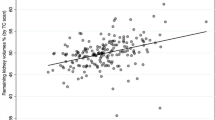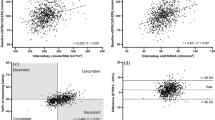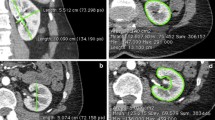Abstract
Background
Selecting the smaller kidney for donation has been advocated if there is a size difference of > 10% between the 2 kidneys but has never been prospectively evaluated. With increase in donor nephrectomies, it is important to evaluate this to minimize loss of renal function to donors.
Methods
75 consecutive donor nephrectomy patients were included in our longitudinal study. The Split Renal Volume (SRV) of bilateral kidneys were measured using contrasted computer tomography scans and patients segregated into 2 groups depending on donated kidney having more (Group 1) or less than (Group 2) 52.5% of SRV.
Results
Patients in Group 1 (n = 19) and 2 (n = 56) were of similar age (43.8 vs. 48.3), BMI (22.4 vs. 25.2), sex (57.9 vs. 55.4% women), respectively. Although total kidney volumes were similar in both groups, Group 1 had significantly smaller right kidney volumes (120.4 ± 24.9 vs. 142.7 ± 28.4 mls, p = 0.003). EGFR pre-operatively (116.3 ± 20.8 vs. 106.3 ± 23.8 mL/min/1.73 m2) and at 6-months (65.7 ± 13.3 vs. 66.9 ± 15.5 mL/min/1.73 m2) were not different between groups. However, patients in Group 1 had significantly greater absolute (50.6 ± 14.9 vs. 39.5 ± 14.7 mL/min/1.73 m2) and relative decline (43.0 ± 8.6 vs. 36.3 ± 10.6%) in eGFR at 6 months (p = 0.06, 0.009).
Conclusion
With a SRV difference of 5% between the 2 sides, removal of the larger kidney for living kidney donation resulted in greater early decline of renal function than kidney donors whose larger or equivalent kidney is preserved.

Similar content being viewed by others
Data availability
Data of this study is available upon request from the corresponding author.
Abbreviations
- ESKD:
-
End stage kidney disease
- LKD:
-
Living kidney donor
- SRV:
-
Split renal volume
- SRF:
-
Split renal function
References
Leichtman AB, Cohen D, Keith D, O’Connor K, Goldstein M, McBride V, Gould CJ, Christensen LL, Ashby VB (2008) Kidney and pancreas transplantation in the United States, 1997–2006: the HRSA Breakthrough Collaboratives and the 58 DSA Challenge. Am J Transplant 8:946–957
Opelz G, Dohler B, Ruhenstroth A, Cinca S, Unterrainer C, Stricker L, Scherer S, Gombos P, Susal C, Daniel V, Tran H (2013) The collaborative transplant study registry. Transplant Rev (Orlando) 27:43–45
Townsend RR, Reese PP, Lim MA (2015) Should living kidney donors with hypertension be considered for organ donation? Curr Opin Nephrol Hypertens 24:594–601
LaPointe RD, Warburton KM (2016) Selection and postoperative care of the living donor. Med Clin North Am 100:599–611
Brar A, Jindal RM, Abbott KC, Hurst FP, Salifu MO (2012) Practice patterns in evaluation of living kidney donors in United Network for Organ Sharing-approved kidney transplant centers. Am J Nephrol 35:466–473
Sarsengaliyev T, Chuvakova E, Tsoy B, Zhangalova A, Gaipov A (2015) Computed tomography in the preoperative and postoperative evaluation of kidney transplant patients. Exp Clin Transplant 13(Suppl 3):88–90
Group ERBPTGD (2013) ERBP guideline on the management and evaluation of the kidney donor and recipient. Nephrol Dial Transplant 28(2):1–71
Yokoyama N, Ishimura T (2015) Usefulness of three-dimensional computerized tomographic volumetry for determining split renal function in donors for living-related kidney transplantation. Transplant Proc 47:588–590
Yanishi M, Kinoshita H, Yoshida T, Takayasu K, Yoshida K, Kawa G, Matsuda T (2015) Comparison of renal scintigraphy and computed tomographic renal volumetry for determining split renal function and estimating post-transplant renal function. Transplant Proc 47:2700–2702
Patankar K, Low RS, Blakeway D, Ferrari P (2014) Comparison of computer tomographic volumetry versus nuclear split renal function to determine residual renal function after living kidney donation. Acta Radiol 55:753–760
Diez A, Powelson J, Sundaram CP, Taber TE, Mujtaba MA, Yaqub MS, Mishler DP, Goggins WC, Sharfuddin AA (2014) Correlation between CT-based measured renal volumes and nuclear-renography-based split renal function in living kidney donors. Clinical diagnostic utility and practice patterns. Clin Transplant 28:675–682
Barbas AS, Li Y, Zair M, Van JA, Famure O, Dib MJ, Laurence JM, Kim SJ, Ghanekar A (2016) CT volumetry is superior to nuclear renography for prediction of residual kidney function in living donors. Clin Transplant 30:1028–1035
Society ECotT (2004) The consensus statement of the amsterdam forum on the care of the live kidney donor. Transplantation 78:491–492
Chiong E, Yip SK, Cheng WS, Vathsala A, Li MK (2004) Hand-assisted laparoscopic living donor nephrectomy. Ann Acad Med Singapore 33:294–297
Goh YS, Cheong PS, Lata R, Goh A, Vathsala A, Li MK, Tiong HY (2014) A necessary step toward kidney donor safety: the transition from locking polymer clips to transfixion techniques in laparoscopic donor nephrectomy. Transplant Proc 46:310–313
Levey AS, Bosch JP, Lewis JB, Greene T, Rogers N, Roth D (1999) A more accurate method to estimate glomerular filtration rate from serum creatinine: a new prediction equation. Modification of Diet in Renal Disease Study Group. Ann Intern Med 130:461–470
Teo BW, Xu H, Wang D, Li J, Sinha AK, Shuter B, Sethi S, Lee EJ (2011) GFR estimating equations in a multiethnic Asian population. Am J Kidney Dis 58:56–63
Dello SA, van Dam RM, Slangen JJ, van de Poll MC, Bemelmans MH, Greve JW, Beets-Tan RG, Wigmore SJ, Dejong CH (2007) Liver volumetry plug and play: do it yourself with ImageJ. World J Surg 31:2215–2221
Goh YS, Wu MW, Tai BC, Lee KC, Raman L, Teo BW, Vathsala A, Tiong HY (2013) Comparison of creatinine based and kidney volume based methods of estimating glomerular filtration rates in potential living kidney donors. J Urol 190:1820–1826
Mjoen G, Holdaas H (2018) Mid- and long-term health risks in living kidney donors. Ann Intern Med 169:265
Segev DL, Muzaale AD, Caffo BS, Mehta SH, Singer AL, Taranto SE, McBride MA, Montgomery RA (2010) Perioperative mortality and long-term survival following live kidney donation. JAMA 303:959–966
Horvat LD, Shariff SZ, Garg AX (2009) Global trends in the rates of living kidney donation. Kidney Int 75:1088–1098
Ahmadi AR, Lafranca JA, Claessens LA, Imamdi RMS., Ijzermans JNM, Betjes MGH, FrankDor JMF (2015) Shifting paradigms in eligibility criteria for live kidney donation: a systematic review. Kidney Int 87:31–45
Dias J, Malheiro J, Almeida M, Dias L, Silva-Ramos M, Martins LS, Xambre L, Castro-Henriques A (2015) CT-based renal volume and graft function after living-donor kidney transplantation: Is there a volume threshold to avoid? Int Urol Nephrol 47:851–859
Poggio ED, Hila S, Stephany B, Fatica R, Krishnamurthi V, del Bosque C, Goldfarb D, Herts B, Dennis VW, Heeger PS, Braun W (2006) Donor kidney volume and outcomes following live donor kidney transplantation. Am J Transplant 6:616–624
Jeon HG, Gong IH, Hwang JH, Choi DK, Lee SR, Park DS (2012) Prognostic significance of preoperative kidney volume for predicting renal function in renal cell carcinoma patients receiving a radical or partial nephrectomy. BJU Int 109:1468–1473
Wu FM, Tay MH, Tai BC, Chen Z, Tan L, Goh BY, Raman L, Tiong HY (2015) Preoperative renal volume: a surrogate measure for radical nephrectomy-induced chronic kidney disease. J Endourol 29:1406–1411
Nyengaard JR, Bendtsen TF (1992) Glomerular number and size in relation to age, kidney weight, and body surface in normal man. Anat Rec 232:194–201
Rathi N, Palacios DA, Abramczyk E, Tanaka H, Ye Y, Li J, Yasuda Y, Abouassaly R, Eltemamy M, Wee A, Weight C, Campbell SC (2022) Predicting GFR after radical nephrectomy: the importance of split renal function. World J Urol 40(4):1011–1018. https://doi.org/10.1007/s00345-021-03918-9. (Epub 2022 Jan 12 PMID: 35022828)
Rathi N, Yasuda Y, Palacios DA, Attawettayanon W, Li J, Bhindi B, Thompson RH, Liss MA, Derweesh IH, Weight CJ, Eltemamy M, Abouassaly R, Campbell SC (2022) Split renal function is fundamentally important for predicting functional recovery after radical nephrectomy. Eur Urol Open Sci 5(40):112–116. https://doi.org/10.1016/j.euros.2022.04.008.PMID:35572817;PMCID:PMC9093013
Funding
Nil.
Author information
Authors and Affiliations
Contributions
LK: Project development, data analysis, manuscript writing. KT: Project development, data analysis, manuscript writing. LT: Data collection, data analysis, manuscript writing. HMP: Data collection, data analysis. BG: Project development. JL: Project development, Data analysis. LR: Data collection, Data analysis. CTB: Data analysis. VA: Manuscript writing. HYT: Project development, data analysis, manuscript writing.
Corresponding author
Ethics declarations
Conflict of interest
The authors have no conflict of interest to declare.
Institution review board approval number
2013/00497-SRF0002.
Additional information
Publisher's Note
Springer Nature remains neutral with regard to jurisdictional claims in published maps and institutional affiliations.
Rights and permissions
Springer Nature or its licensor (e.g. a society or other partner) holds exclusive rights to this article under a publishing agreement with the author(s) or other rightsholder(s); author self-archiving of the accepted manuscript version of this article is solely governed by the terms of such publishing agreement and applicable law.
About this article
Cite this article
Kyaw, L., Thandapani, K., Tan, L. et al. Choosing the larger kidney on CT volumetry: a study on the early post-donation kidney function of living donors. Int Urol Nephrol 56, 97–102 (2024). https://doi.org/10.1007/s11255-023-03737-4
Received:
Accepted:
Published:
Issue Date:
DOI: https://doi.org/10.1007/s11255-023-03737-4




